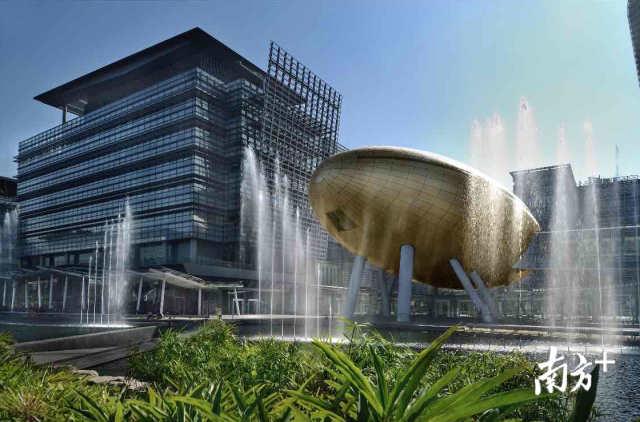Hong Kong Sci-tech Park. (Source: Nanfang Plus)
On August 15th, the leadership group of the Guangzhou-Hong Kong-Macao Greater Bay Area Development proposed an initiative to build a scientific and technological innovation corridor threading through Guangzhou, Shenzhen, and Hong Kong to Macao; transforming the Bay Area into an international scientific and technological innovation center. To integrate the advantages presented by Hong Kong as an international finance centre with Guangdong’s manufacturing is key to driving the development of both this Corridor and the Bay Area.
The development of Bay Area could be accelerated by the free flow of venture capital and of technological talent. Experts thus suggest establishing a pilot area and a fund pool for science and technological innovation as well as the Bay Area alliance, to accelerate the flow of capital and talent.
Planned by Xie Meiqin, Luo Yanjun, Zhangying, Guo Jiaxuan, Chen Yin
Reported by Peng Lin, Tang Zitian, Guo Jiaxuan, Tang Liuwen, Zhang Jun, Gong Ming (Intern)
Edited by Wing, Nan & Simon
X Foundation Co-founder Chen Guanhua (M) with reporters from Nanfang Daily.(Source: Nanfang Plus)
Ever-closer ties between science, innovation and investment
X Foundation was co-founded by Shen Nanpeng, the global executive partner of Sequoia Capital, Li Zexiang, professor from the Hong Kong University of Science and Technology and Chen Guanhua, professor from the University of Hong Kong two years ago. Among them, Li Zexiang is the tutor of Wang Tao, the founder of DJ-Innovations. His idea of the unmanned aerial vehicle was originally conceived at the Hong Kong University of Science and Technology. Nowadays, X foundation serves as a bridge connecting Hong Kong with mainland China in sci-tech innovation .
Chen Guanhua told reporters that in the past two years, many technology-based companies, though born in Hong Kong, move to the mainland to explore the market after being financed by venture capitalists. Business applications are gaining great momentum, such as DJ-Innovations, SenseTime and Orbbec.
Lei Zhibin, R&D director of the intelligent software and systems department of the Hong Kong Applied Science and Technology Research Institute (ASTRI) believes that the Bay Area is positioned as an international technology innovation center. Guangdong, Hong Kong and Macao are all able to support each other. Given the fact that Guangdong has undertaken the task of manufacturing from chips to optoelectronic components for ASTRI, Hong Kong’s hunger for the mainland market is growing apace. It is essential for Guangzhou, Shenzhen and Macao to utilize the advantage of Hong Kong provides as an international financial hub, in a bid to help the scientific and technological innovation corridor go global.
A Brochure of Hong Kong Sci-Tech Park. (Source: Nanfang Plus)
Restraint of capital and talent flow
Chen Guanhua said that venture capital in Hong Kong would have to be converted from HKD into RMB before being invested in the mainland. Yet, capital finance flow between Hong Kong and the mainland is not yet trouble-free, which creates an immediate impact on the development of the Bay Area.
Li Yinghao, co-founder of QFpay is from Hong Kong and chose to start his own business on the mainland. As his company has grown, he has begun seeking a new round of financing from a Hong Kong fund. Investors in Hong Kong, he says, have better access to Southeast Asia, Europe and the United States and other overseas markets. “The initial financing was in RMB. If the company receives investment from the Hong Kong fund, it means necessity of currency conversion, and then a cumbersome investment transaction process.”
Zhou Jian, founder and CEO of UBTECH a company developing robots based in Shenzhen said that venture capital in Guangdong is still imbalanced among different regions, with Shenzhen coming out top. If Hong Kong’s venture capital can get more quick and convenient access to Guangdong market, technology-based enterprises will find more sources of finance. “These start-ups require a large amount of capital to drive technology growth. So, their future is determined by financing patterns.”
Moreover, those who chose Shenzhen to start their business encounter problems from visas to social insurance. They need more support from the government in these aspects.
From the viewpoint of Shen Nanpeng, the global executive partner of Sequoia Capital, to boost innovation in science through financing requires setting up a conducive environment. “The success of any city as a science and technology center lies in a good environment.”

Hong Kong Sci-tech Park. (Source: Nanfang Plus)
Pilot area & fund pool
According to the blueprint, Lok Ma Chau Loop is the pilot area for Shenzhen-Hong Kong cooperation.
In February, Hong Kong announced its budget for 2018-2019, proposing to set aside HKD 20 billion for the first phase of the Hong Kong-Shenzhen Innovation and Technology Park in Lok Ma Chau Loop.
Chen Guanhua said that foreign capital has to be approved by several parties before flowing into the Qianhai FTZ. The area is attempting to reduce these administrative procedures. Qianhai FTZ has put forward proposals to expand the scope of offshore RMB in the pilot scheme, and has started discussions with the Hong Kong government.
Nansha, also as a pilot area, is the sixth state-level new district. Cai Chaolin, a member of the Standing Committee of the Guangzhou Municipal Committee and Party secretary for Nansha District, suggested granting full national treatment to Hong Kong and Macao residents currently in Nansha New District.
The Hong Kong X Foundation and Qianhai Free Trade Zone attempted to establish a fund pool for science and technology innovation, allowing both HKD and RMB to be hedged in the pool.
“In the short term, abundant funds can attract talent , but funds alone are not enough to persuade them to stay,” According to Lei Zhibin, the key issue lies in building a strong concept for the Bay Area. He suggested that government and industry consider setting up an alliance to serve the Bay Area, providing start-ups with services ranging from registration, credit rating and financing in different cities.




















